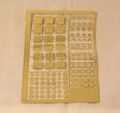Photo-Etched Brass
| This article or section is about something oldschool - and awesome. Make sure your rose-tinted glasses are on nice and tight, and prepare for a lovely walk down nostalgia lane. |

Holy shit, why are you here of all places?
Photo-Etched Brass is a material and technique that is used when making highly detailed model parts. These parts are flat, delicate bits of brass that are easy to bend, but can retain huge amounts of detail. This makes these parts ideal for very fine details like gauge clusters, small iconography, and expensive finery like wall moldings and chandeliers. Photo-etched brass parts usually came with expensive model railroading kits or model airplane kits from the 60's through to the 2000's, so you probably have never used them before.
If It's So Detailed, Why Is It Dead?[edit]
Photo-etching is an old technique, which is not used much for making models anymore. That's not to say it isn't done: many companies which specialize in high-detail scale models have been around since photo-etched brass was in vogue, and they're still doing it. That being said, you aren't going to see high-volume tabletop war games switch back to brass any time soon. The reason is threefold:
- It's fucking fiddly. Photo-etching brass takes time and attention. Each step in the process requires you to work precisely with chemicals, some of which you don't want to touch, and others of which cannot be exposed to light for very long. If you leave an etching in the acid bath for too long, you ruin the etching completely and make acid slurry byproducts for nothing. The fastest turn-around time on a single brass etching is like, a day and a half.
- It's fucking dangerous. Photo-etching requires strong acids and UV lights, both of which are bad for you if your job is to be exposed to them 24/7. The used-up acids are a nasty by-product of the manufacturing process, that are tough to dispose of.
- It's fucking unnecessary. Back in the old days, plastic models just couldn't be made well enough to compete with the detail of brass. By the 2010's, plastic moulding techniques have evolved enough that fine details and repeatable precision are no longer a problem. With model companies constantly finding new techniques for improving their plastic and resin model kits, why bother with brass?
These days the only people who sell photo-etched brass parts in wargaming are 3rd party shops online, and Forge World. Games Workshop themselves has long-since switched over to transfers for adding surface details to their plastic models.
DIY[edit]
Given all of what you just read, why the fuck would you want to make your own etched brass parts? In a word: detail. You can get very tiny details with photo-etching, and retain them with relatively-durable brass. When it comes to adding mouldings or raised iconography on armor, green stuff just does not do the job as well. Even commercial photo-curing 3D printers (as of 2020) can have trouble making details at the scale brass etching can reliably get down to, particularly when wrapping those etchings around pre-existing model geometries.
Furthermore, photo-etched brass is reproducible! Most modern at-home techniques require you to print out a design on paper (or on a see-though trace), which means that you can duplicate the same exact design dozens or hundreds of times. If you want to customize a whole chapter of Space Marines with a unique and detailed emblem, you should definitely consider brass etchings before freehand painting hundreds of welsh dragons (or whatever).
External Links[edit]
Gallery[edit]
| Model Making | |
|---|---|
| Modeling: | Guide to Assembling Models - Green Stuff - Model Alternatives - Casting - Photo-Etched Brass |
| Painting: | Guide to Painting Models - Paint - THIN YOUR PAINTS - Duncan Rhodes - 'Eavy Metal |
| Scenery and Technical: | Forthcoming... |
| Related: | WIP |

